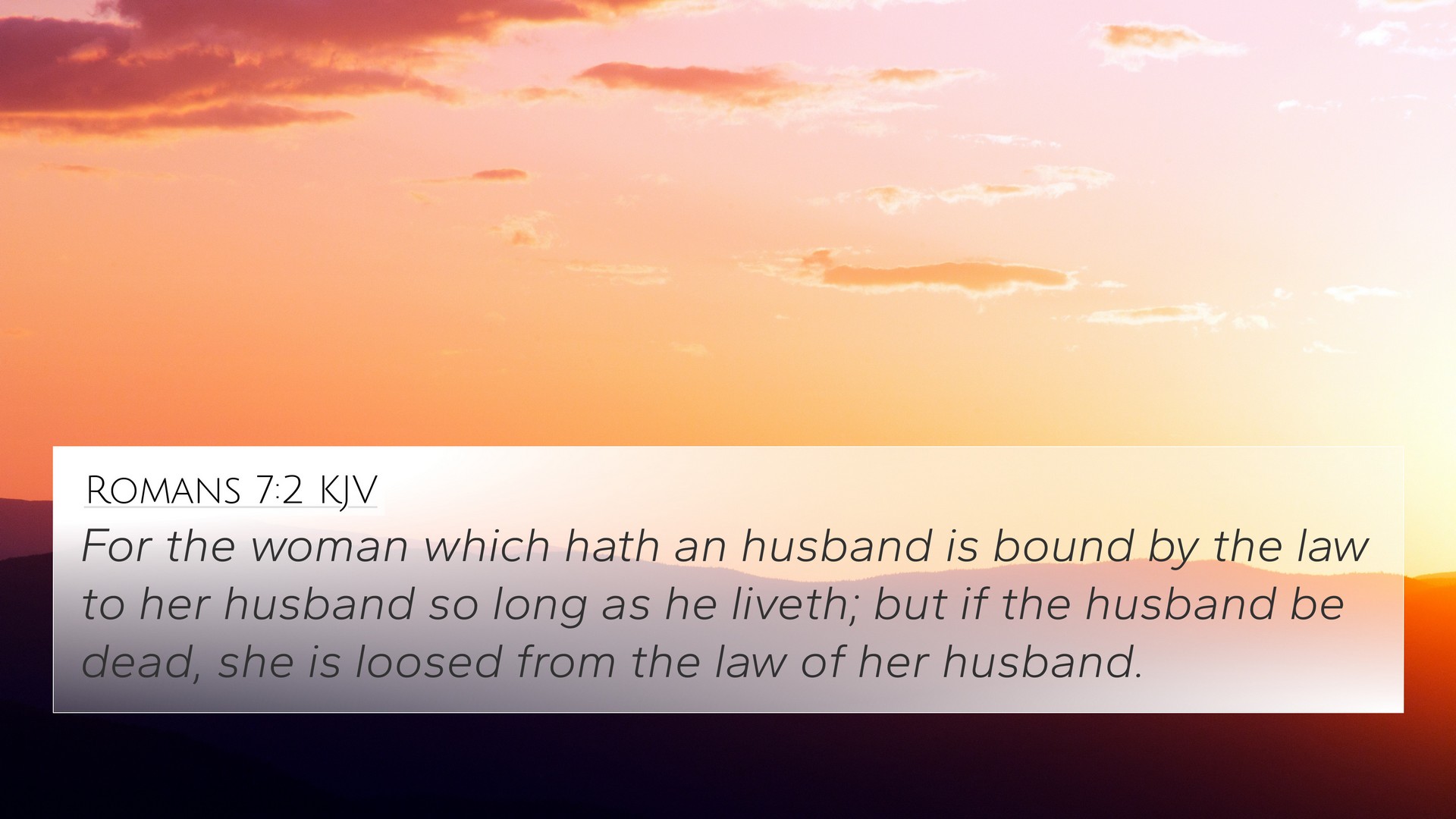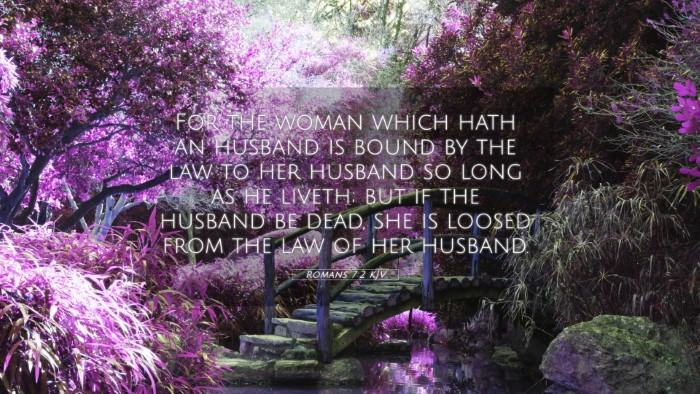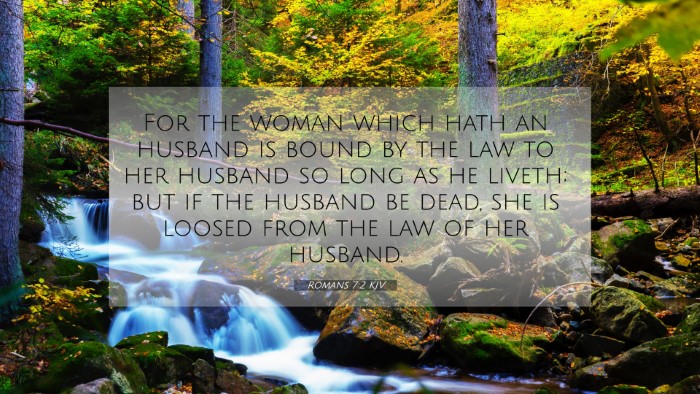Old Testament
Genesis Exodus Leviticus Numbers Deuteronomy Joshua Judges Ruth 1 Samuel 2 Samuel 1 Kings 2 Kings 1 Chronicles 2 Chronicles Ezra Nehemiah Esther Job Psalms Proverbs Ecclesiastes Song of Solomon Isaiah Jeremiah Lamentations Ezekiel Daniel Hosea Joel Amos Obadiah Jonah Micah Nahum Habakkuk Zephaniah Haggai Zechariah MalachiRomans 7:2 Similar Verses
Romans 7:2 Cross References
For the woman which hath an husband is bound by the law to her husband so long as he liveth; but if the husband be dead, she is loosed from the law of her husband.
Uncover the Rich Themes and Topics of This Bible Verse
Listed below are the Bible themes associated with Romans 7:2. We invite you to explore each theme to gain deeper insights into the Scriptures.
Romans 7:2 Cross Reference Verses
This section features a detailed cross-reference designed to enrich your understanding of the Scriptures. Below, you will find carefully selected verses that echo the themes and teachings related to Romans 7:2 KJV. Click on any image to explore detailed analyses of related Bible verses and uncover deeper theological insights.

Genesis 2:23 (KJV) »
And Adam said, This is now bone of my bones, and flesh of my flesh: she shall be called Woman, because she was taken out of Man.
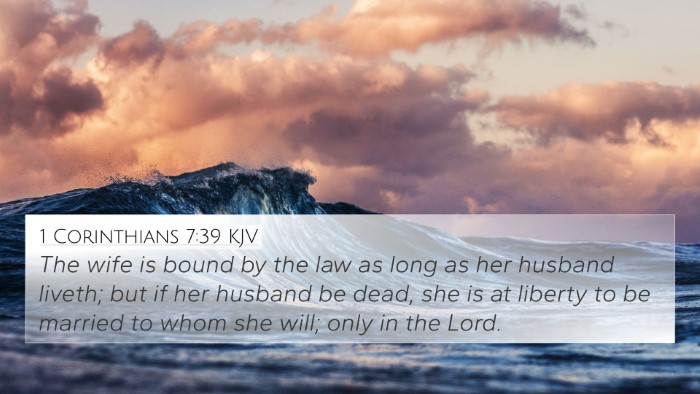
1 Corinthians 7:39 (KJV) »
The wife is bound by the law as long as her husband liveth; but if her husband be dead, she is at liberty to be married to whom she will; only in the Lord.
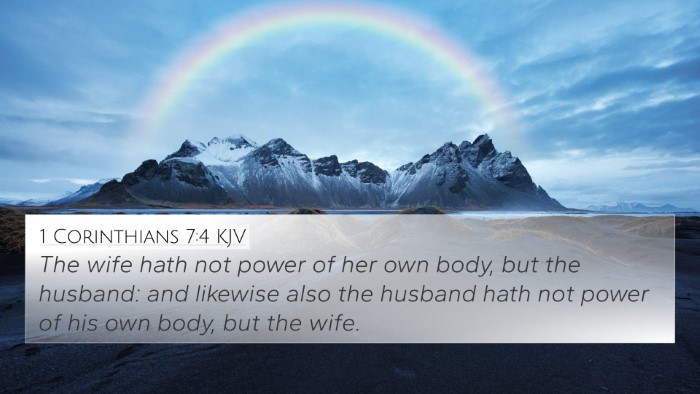
1 Corinthians 7:4 (KJV) »
The wife hath not power of her own body, but the husband: and likewise also the husband hath not power of his own body, but the wife.
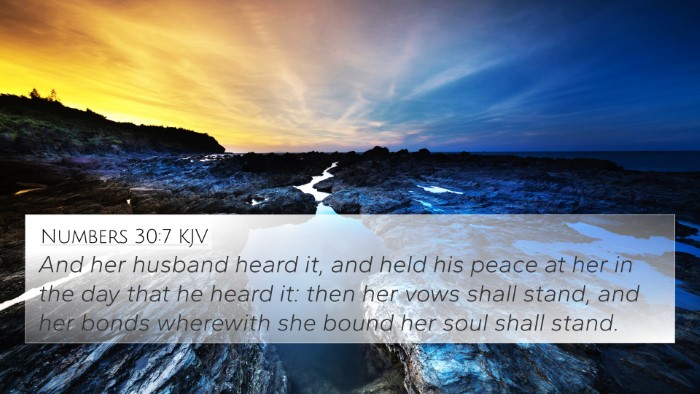
Numbers 30:7 (KJV) »
And her husband heard it, and held his peace at her in the day that he heard it: then her vows shall stand, and her bonds wherewith she bound her soul shall stand.
Romans 7:2 Verse Analysis and Similar Verses
Understanding Romans 7:2
Bible Verse: Romans 7:2
“For the woman which hath an husband is bound by the law to her husband so long as he liveth; but if the husband be dead, she is loosed from the law of her husband.”
Overview
This verse finds its place in a discussion by the Apostle Paul concerning the relationship of believers to the law, illustrating that the law has authority only as long as one is alive. Paul uses the example of marriage to depict this principle.
Commentary Insights
-
Matthew Henry:
Henry explains that the law binds individuals as long as they live. In this context, marriage represents a covenant requiring fidelity, with the law providing the binding force. Once the husband dies, the wife is free from this binding law, symbolizing the believer’s release from the law through the death of Christ.
-
Albert Barnes:
Barnes notes that while in marriage, the law dictates commitment until death, contrasting this with spiritual freedom in Christ. This verse implies that believers are released from the demands of the law through Christ's death, enabling a new allegiance to Him.
-
Adam Clarke:
Clarke emphasizes the legal binding in marriage reflecting the constraints placed by the law. He points out that this comparison serves to explain that the death of Christ frees believers from the ceremonial law, just as the death of a spouse frees one from marital obligations.
Biblical Cross-References
Understanding Romans 7:2 is enriched by cross-referencing with various related scriptures. Here are some verses that provide additional insights:
- Romans 6:6: “Knowing this, that our old man is crucified with him, that the body of sin might be destroyed, that henceforth we should not serve sin.”
- 1 Corinthians 7:39: “The wife is bound by the law as long as her husband liveth; but if her husband be dead, she is at liberty to be married to whom she will; only in the Lord.”
- Galatians 2:19: “For I through the law am dead to the law, that I might live unto God.”
- Hebrews 7:12: “For the priesthood being changed, there is made of necessity a change also of the law.”
- Colossians 2:14: “Blotting out the handwriting of ordinances that was against us, which was contrary to us, and took it out of the way, nailing it to his cross.”
- Romans 8:2: “For the law of the Spirit of life in Christ Jesus hath made me free from the law of sin and death.”
- Luke 16:18: “Whosoever putteth away his wife, and marrieth another, committeth adultery; and whosoever marrieth her that is put away from her husband committeth adultery.”
Thematic Connections
Romans 7:2 introduces themes of legal obligations and spiritual freedom. It showcases the intricate connections between marriage laws in the Old Testament and the New Testament revelations regarding the believer's relationship to the law:
- Law and Grace: The transition from the demands of the law to the grace given through Christ.
- Life and Death: The duality of life in Christ, as death brings freedom from sin and the law.
- Marriage Symbolism: The metaphor of marriage, representing the bond believers have with the law versus their union with Christ.
Exploring Related Themes
This section delves into how these themes resonate throughout the Scriptures:
-
Tools for Bible Cross-Referencing:
Using a Bible concordance or a cross-reference guide is essential in examining connections between verses and understanding their implications.
-
Inter-Biblical Dialogue:
The connections between Old Testament laws and New Testament teachings reveal a cohesive narrative of redemption and grace.
-
Comparative Bible Verse Analysis:
This is crucial for deeper understanding, especially looking at Pauline epistles which frequently address the law's role and believers’ new identity in Christ.
Conclusion
In conclusion, Romans 7:2 not only illustrates the binding nature of law through the lens of marriage but also signifies the transformational power of Christ's death that liberates believers. Through careful analysis and cross-referencing with key Bible verses, one can gain a comprehensive understanding of the spiritual truths embedded in this scripture.
Further Studies
For those looking to deepen their understanding of Scripture, consider exploring:
- How to find cross-references in the Bible.
- Identifying connections between the Old and New Testament.
- Detailed cross-reference between the Gospels.
- Cross-referenced themes in the Bible for sermon preparation.
